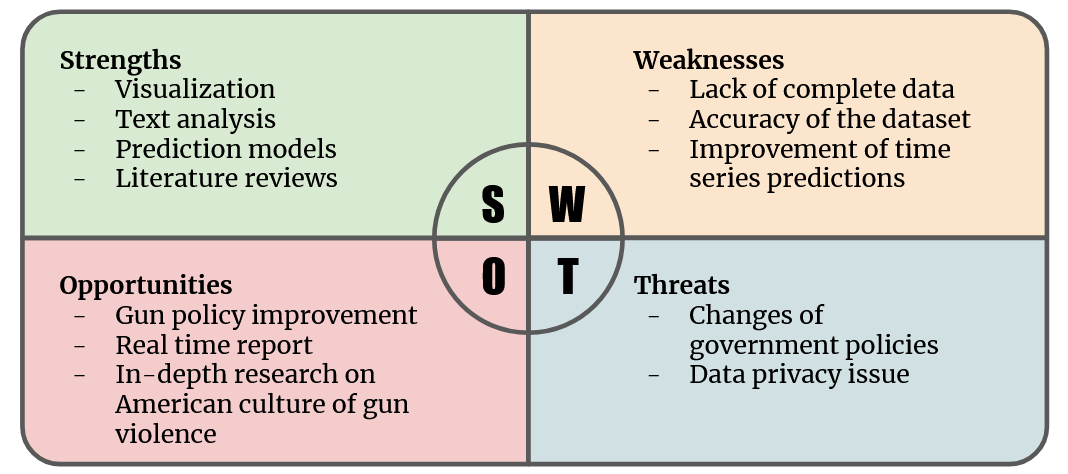SWOT Analysis
Conclusions and Considerations
We understand that tackling the full breadth of gun violence in the U.S. is beyond the scope of this project. There are also limitations to our data – for example, racial information is not included in our original data set with each incident (although it is factored into our cluster analyses), and in general, there is a lack of complete data available, especially with regard to non-fatal injuries as a result of firearms.
From our analysis, we can conclude that incidents tended to occur in larger, more urban areas as opposed to more rural areas. We also found evidence supporting sex-disparities – regardless of whether the participant was a victim or a suspect, there was a much higher likelihood that the participant would be male. Most suspects and victims were adults, and while armed robbery was the most frequent relationship status to appear, a large number of incidents involved victims who knew the suspect (family, significant others, friends). While the most frequently reported status of the suspects was of arrest, there were still nearly 20,000 suspects that were not. Additionally, we found that guns used in the incidents were much more likely to be stolen handguns as opposed to any other type.
When running a cluster analysis by state, only one of the nine states found to be in the gun violence cluster (Illinois) has licensing requirements for gun purchase or possession, supporting their use as deterrents of gun violence.
Factoring in our research, we know that the American people may not be nearly as divided on stricter gun policy as the media may lead us to believe (Barry et al., 2018). This gives hope that change can occur if we tactfully approach the topic with emphasis not on curtailing individual rights, but on safety, demonstrating that it is possible to consider the collective good without sacrificing individual freedom. In order to do this, we also need to work on de-politicizing the issue.
Rightfully so, social justice movements have called attention to racial disparities in stops, arrests, and imprisonments of Black males as a result of overly aggressive policing and mass incarceration policies, which feed into the vicious cycle of continuing poverty and community violence that repeat in the areas where gun violence occurs most prominently. However, de-policing is not the answer; rather, large scale police overhaul and reform is. A well-functioning criminal justice system can deter shooters and can be utilized as a form of primary prevention in the public health approach. It is of utmost importance that criminologists collaborate with public health experts in further research on prevention strategies. On the note of future research and prevention efforts, due to the disparities in sex and race, such efforts should be focused within specific demographic factors.
Regarding lack of complete and high-quality data concerning firearm violence, police agencies and hospitals should be mandated to report to the National Incident-Based Reporting System (Morral and Smart, 2022).
Additionally, focused efforts should be placed on safe storage practices and permit-to-purchase (PTP) laws, which have demonstrated their effectiveness in reducing firearm violence. There are 8% lower youth firearm suicide rates in states with laws that mandate gun owners prevent access to firearms by children (Webster, et al., 2004). States with PTP laws in place did not appear in the gun violence cluster when analyzed on a state level. Connecticut’s PTP laws were associated with significant reductions in firearm homicide and suicide, while the repeal of Missouri’s PTP laws were associated with increases.
With the recent significant increases in federal funding for research on firearm violence, we are hopeful that strides will be made to benefit our society and make it a safer place. Of course, there are still many hurdles, but we believe this project has given us some insight into what these hurdles are and how they can eventually be overcome. As individuals, we can focus on having the tough conversations with people around us and work on de-politicizing the issue.
